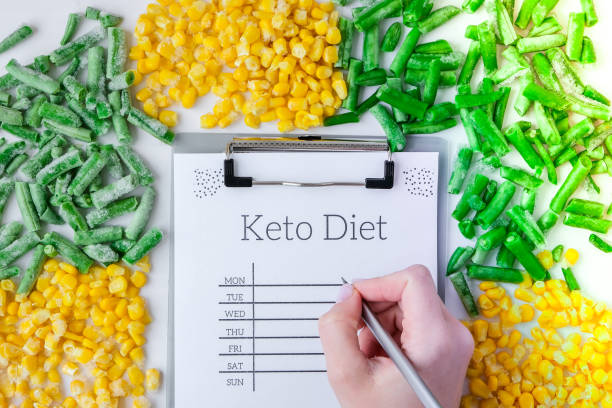Introduction
The keto diet has become one of the most popular eating plans in recent years. People turn to it for weight loss, steady energy, and better focus throughout the day. Some even report reduced cravings and improved mental clarity. But for those living with diabetes, the question goes beyond simple weight loss: Can the keto diet really help manage blood sugar in a safe and effective way?
If you have diabetes, you already know that food choices play a major role in how you feel and how well you control your blood sugar. Every meal matters because carbs, protein, and fats all affect blood sugar in different ways. Since the keto diet is very low in carbs and high in healthy fats, it may help reduce sugar spikes and improve insulin sensitivity. This makes it appealing to people with Type 2 diabetes who want better blood sugar control. However, like any eating plan, keto has both benefits and risks. It is not a one-size-fits-all solution, and it may not be safe for everyone.
In this article, we’ll take a closer look at how the keto diet works, what the science says about its impact on diabetes, the benefits it may provide, and the possible side effects you should consider before making the switch.
What Is the Keto Diet?
The ketogenic diet, often called “keto,” is a low-carb, high-fat eating plan designed to change how your body uses energy. Instead of relying on carbs as the main fuel, keto shifts your body into burning fat.
- Carbs are limited to about 20–50 grams per day, which is much lower than the typical diet. This strict carb limit is what helps the body switch into a new metabolic state.
- Fats make up about 70–80% of total calories. These fats should come mostly from healthy sources like avocados, nuts, olive oil, and fatty fish.
- Protein is moderate, usually around 20%. Too much protein can interfere with ketosis, so balance is important.
When carbs are cut this low, your body enters a state called ketosis. In ketosis, your body burns fat instead of carbs for energy. This process produces molecules called ketones, which fuel your brain, muscles, and organs. Many people notice steadier energy and fewer cravings once they reach this state.
This switch in energy source is what makes the keto diet unique—and why it may affect diabetes by lowering blood sugar spikes and improving insulin response.diabetes.
Diabetes and the Role of Carbohydrates
To understand how keto may help, you first need to know how carbs affect blood sugar.
- Carbs break down into glucose after you eat.
- Glucose enters your bloodstream, raising blood sugar levels.
- Insulin, a hormone from your pancreas, helps move glucose into your cells.
In people with diabetes, this process doesn’t work well. Either the body doesn’t make enough insulin (Type 1) or can’t use insulin properly (Type 2). Too many carbs can lead to spikes in blood sugar, which cause long-term complications.
By reducing carbs, the keto diet lowers the amount of glucose entering the bloodstream. This may improve blood sugar control and reduce the need for high doses of medication.

Keto Diet Benefits for Diabetes
Many people report better blood sugar control and weight loss with keto. Research also supports some of these benefits.
1. Improved Blood Sugar Levels
Studies show that a keto diet can lead to lower HbA1c levels, which measure average blood sugar over three months. In some cases, people with Type 2 diabetes were able to reduce or stop certain medications under medical supervision.
👉 A study published in the journal Diabetes Therapy found that patients with Type 2 diabetes on a low-carb diet had better blood sugar control compared to those on a low-fat diet.
2. Weight Loss Support
Extra weight makes it harder for your body to use insulin. Losing weight, even a little, can improve insulin sensitivity. The keto diet often leads to faster weight loss because it reduces hunger and promotes fat burning.
3. Lower Triglycerides and Improved Cholesterol
Some research shows keto can improve certain heart health markers. Lower triglycerides and higher HDL (good cholesterol) may reduce the risk of heart disease, which is a concern for many people with diabetes.
4. Better Energy and Reduced Cravings
Since the keto diet stabilizes blood sugar levels, many people report fewer crashes, less brain fog, and reduced cravings for sugary foods.
Risks and Drawbacks of Keto for Diabetes
While keto may help, it’s not risk-free. People with diabetes need to be cautious.
1. Risk of Low Blood Sugar (Hypoglycemia)
If you take insulin or medications like sulfonylureas, cutting carbs too low can cause dangerously low blood sugar. This is why medical supervision is essential.
2. Nutrient Deficiencies
The keto diet cuts out many fruits, whole grains, and legumes. These foods are rich in fiber, vitamins, and minerals. Without careful planning, you may miss out on key nutrients.
3. Keto Flu
When starting keto, some people experience fatigue, headaches, nausea, and irritability. This is called the “keto flu” and usually lasts a few days. Staying hydrated and eating enough electrolytes can help.
4. Long-Term Concerns
There’s still limited research on the long-term effects of keto for people with diabetes. Some experts worry about kidney strain, liver health, and very high cholesterol in certain individuals.

Who Should Not Try the Keto Diet?
Keto may not be safe for everyone. You should avoid keto if you:
- Have Type 1 diabetes (higher risk of ketoacidosis)
- Are pregnant or breastfeeding
- Have kidney or liver disease
- Have a history of eating disorders
Always talk with your doctor before starting keto, especially if you take diabetes medications.
How to Safely Try Keto with Diabetes
If you and your doctor decide keto is a good fit, follow these steps for safety and success.
Step 1: Work with Your Healthcare Team
Never start keto on your own if you have diabetes. A doctor or dietitian can adjust your medications and monitor your progress.
Step 2: Focus on Healthy Fats
Not all fats are equal. Choose:
- Avocados
- Olive oil
- Nuts and seeds
- Fatty fish like salmon
Avoid too much processed meat, butter, or fried foods.
Step 3: Choose Low-Carb Vegetables
Fill your plate with non-starchy veggies:
- Spinach
- Broccoli
- Cauliflower
- Zucchini
These provide fiber, vitamins, and minerals without raising blood sugar.
Step 4: Monitor Blood Sugar Regularly
Check your levels often, especially in the first weeks. Keto may lower blood sugar quickly, so adjustments in medication may be needed.
Step 5: Stay Hydrated and Get Electrolytes
Drink water and add foods rich in sodium, potassium, and magnesium to avoid dehydration and muscle cramps.
Alternatives to Keto for Diabetes
Keto is not the only option for managing diabetes. Other diets may also help without being as restrictive.
- Mediterranean Diet – Focuses on whole grains, fish, olive oil, and vegetables. Backed by strong research for heart health.
- DASH Diet – Aimed at lowering blood pressure but also helpful for blood sugar control.
- Plate Method – A simple way to balance meals with half vegetables, one-quarter protein, and one-quarter carbs.
👉 The American Diabetes Association provides resources on safe eating patterns for diabetes.

Keto Diet and Diabetes: Real Stories
Many people with diabetes share success stories about the keto diet. They report weight loss, better blood sugar control, fewer medications, and more energy in their daily lives. Some even notice improved focus and fewer cravings for sweets or carbs. These results can be very motivating for people who have struggled with traditional diets.
However, not everyone has the same results. Some find it hard to stick with such a strict low-carb plan, especially over the long term. Others may experience side effects like fatigue, nutrient gaps, or changes in cholesterol levels. In some cases, people may need frequent adjustments to their diabetes medication to stay safe while on keto.
This shows that keto is not a one-size-fits-all solution. What works for one person may not work for another. Each body responds differently, and factors like age, activity level, and overall health play a big role in success. For this reason, it’s always best to approach keto with medical guidance and to listen to your body along the way.
Key Takeaways
- The keto diet may improve blood sugar control and help with weight loss in people with Type 2 diabetes.
- Risks include nutrient deficiencies, low blood sugar, and possible long-term concerns.
- It’s not safe for everyone, especially those with Type 1 diabetes or certain health conditions.
- Always consult your doctor before starting keto.
Conclusion
So, does the keto diet really help with diabetes? The answer is: It can—but it depends on you. For some, keto offers better blood sugar control and weight loss. For others, the risks may outweigh the benefits.
If you’re curious about keto, talk with your healthcare provider. Together, you can decide if it’s the right path or if another eating plan may work better.
Have you tried the keto diet for diabetes—or are you considering it? Share your thoughts and experiences in the comments below. Your story could inspire others on the same journey!

